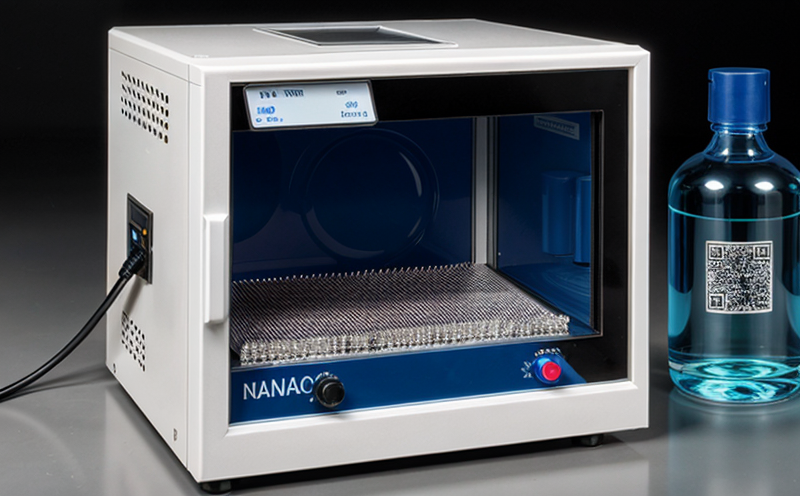ISO 13320 Nanoparticle Size Distribution Testing by Laser Diffraction
The ISO 13320 standard provides a comprehensive methodology for determining the size distribution of nanoparticles using laser diffraction. This technique is particularly useful in sectors such as pharmaceuticals, electronics, and environmental science where understanding the size characteristics of nanoparticles can significantly impact product performance, safety, and regulatory compliance.
The laser diffraction method measures the scattering pattern produced when a laser beam interacts with particles suspended in a fluid medium. By analyzing this pattern, detailed information about the size distribution and concentration of nanoparticles can be obtained. This non-destructive technique is widely used for its precision and repeatability.
For accurate testing, specimens must undergo rigorous preparation to ensure uniform particle dispersion and minimal aggregation. The particles are typically suspended in a suitable dispersing medium like water or ethanol before being introduced into the laser diffraction instrument. Proper calibration of the instrument is also crucial for obtaining reliable results.
The ISO 13320 standard specifies various parameters that must be considered during testing, including the wavelength of the laser used, the refractive index of the dispersing medium, and the particle concentration range over which measurements are taken. These factors significantly influence the accuracy and precision of the results.
The reported data typically includes cumulative volume distribution curves, weight-based size distributions, and individual particle sizes. This information is invaluable for optimizing manufacturing processes, ensuring product consistency, and meeting regulatory requirements.
Understanding the nanoparticle size distribution is critical in fields like nanotechnology where particles at specific size ranges exhibit unique properties. For instance, smaller nanoparticles may have higher reactivity while larger ones might be more stable. Accurate sizing helps in tailoring products to meet specific performance criteria or ensure safety standards are met.
- Environmental and Sustainability Contributions: Nanoparticles used in various industries can pose environmental risks if not properly managed. By accurately determining their size distribution, manufacturers can minimize potential harm by optimizing particle size to enhance dispersibility and reduce aggregation, thus improving the overall efficiency of waste management processes.
- Competitive Advantage and Market Impact: In competitive markets, understanding nanoparticle properties is key to innovation. Companies that excel in this area can gain a significant edge by ensuring their products are both safe and effective, leading to increased market share and customer trust.
Applied Standards
The ISO 13320 standard is widely recognized as the gold standard for nanoparticle size distribution testing. It ensures consistency across different laboratories and instruments, facilitating international collaboration and harmonization of regulatory requirements.
In addition to ISO 13320, other relevant standards include ASTM D5698-04(2020) which covers the use of laser diffraction for particle size analysis. These standards provide comprehensive guidance on specimen preparation, instrument calibration, and data interpretation.
The application of these standards is crucial not only in ensuring accurate measurements but also in maintaining industry-wide confidence in nanoparticle testing results. Regulatory bodies like the FDA, EMA, and others often require compliance with such standards to approve new products containing nanoparticles.
Environmental and Sustainability Contributions
The accurate determination of nanoparticle size distribution plays a pivotal role in environmental sustainability. By ensuring that nanoparticles are used responsibly, industries can minimize their ecological footprint. For example, knowing the precise size range of nanoparticles in wastewater can help in developing more effective remediation strategies.
Nanoparticles have unique properties that make them attractive for use in various applications such as cosmetics and pharmaceuticals. However, improper handling or disposal can lead to environmental contamination. Accurate testing ensures that these particles are used efficiently and safely, reducing the risk of unintended ecological impacts.
Incorporating nanoparticle size distribution data into product lifecycle assessments (LCA) helps in identifying potential risks associated with their use throughout production, usage, and disposal phases. This information is essential for developing sustainable practices that minimize environmental impact.
Competitive Advantage and Market Impact
In highly competitive markets, the ability to accurately determine nanoparticle size distribution can provide a significant competitive advantage. Companies that excel in this area are better positioned to innovate and bring safer, more effective products to market faster.
The ISO 13320 standard ensures consistency across different testing environments, allowing companies to benchmark their processes against industry leaders. This transparency fosters trust among consumers and stakeholders, enhancing brand reputation.
Moreover, compliance with these standards is often a prerequisite for regulatory approval, which can be a deciding factor in market entry. By adhering to international best practices, companies not only meet legal requirements but also demonstrate their commitment to quality and safety, thereby gaining a competitive edge.





